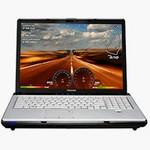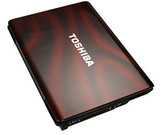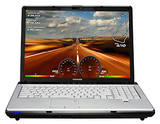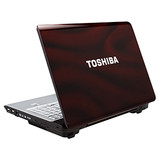Toshiba Satellite X205-SLi4
Specifications

Price comparison
Average of 3 scores (from 3 reviews)
Reviews for the Toshiba Satellite X205-SLi4
Source: Laptop Mag
 Archive.org version
Archive.org versionAt $2,199, the Toshiba Satellite X205-SLi4 offers decent performance, but its scores were so close to the much more affordable Gateway P-6831FX that we’re hard-pressed to recommend it. For $850 less you get comparable gaming scores (better on some tests, worse on others), longer battery life, and a ready-to-play configuration—without updates, downloads, hotfixes, and setting tweaks. The biggest reasons to get this system versus the Gateway are its higher-resolution display and larger hard drive (320GB versus 250GB), which isn’t enough justification in our book.
2.5 von 5, Display gut, Leistung mangelhaft
Single Review, online available, Medium, Date: 03/24/2008
Rating: Total score: 50% performance: 50% display: 80%
Source: CNet
 Archive.org version
Archive.org versionWe've always appreciated the inexpensive SLI options offered by Toshiba's gaming-oriented X205 series, but it's hard to recommend the X205-SLi4 when other vendors offer better frame rates for almost $1,000 less.
6 von 10, Leistung gut, Mobilität schlecht
Single Review, online available, Medium, Date: 03/17/2008
Rating: Total score: 60% performance: 80% mobility: 40%
Source: PC Mag
 Archive.org version
Archive.org versionToshiba doesn't take it slow when it comes to updating the Satellite brand. Ever since the company launched its first gaming laptop—the Satellite P105-S921—in early 2006, the torrential downpour of beastly laptops equipped with powerful graphics cards hasn't ceased. The Toshiba Satellite X205-SLi4 may not have performance bragging rights, but the reasonable price tag should bring new gaming talent out of the woodwork.
3.5 von 5, Leistung gut, Mobilität mangelhaft
Single Review, online available, Short, Date: 03/11/2008
Rating: Total score: 70% performance: 80% mobility: 50%
Comment
NVIDIA GeForce 8600M GT: The NVIDIA GeForce 8600M GT is the DirectX 10 capable successor of the GeForce Go 7600 GT GPU for laptops. Depending on the used graphic memory and the clock speed, the performance is between the 7600 GT and 7900 GS video card.
Only some 3D games with very low demands are playable with these cards.
» Further information can be found in our Comparison of Mobile Graphics Cards and the corresponding Benchmark List.
Intel Core 2 Duo: This is the Core Duo and Core Solo successor with a longer pipeline and 5-20% more speed without more power consumption. As an addition to the Core Duo design there exists a fourth decoder, an amplified SSE-unit and an additional arithmetical logical unit (ALU).
The Core 2 Duo for laptops is identical to the desktop Core 2 Duo processors but the notebook-processors work with lower voltages (0.95 to 1188 Volt) and a lower Frontside bus clock (1066 vs 667 MHz). The performance of equally clocked notebooks is 20-25% lower than Desktop PCs because of the lower Frontside bus clock and the slower hard disks.
T8100: Former mid-range Core 2 Duo based on the Penryn core that features FSB800 and VT-x virtualization functions.» Further information can be found in our Comparison of Mobile Processsors.














